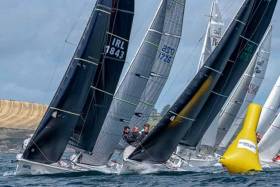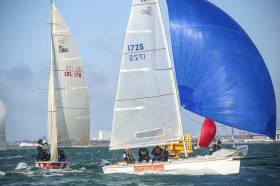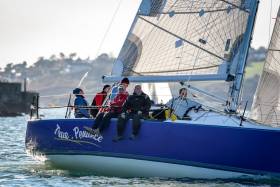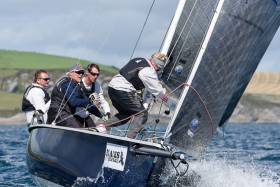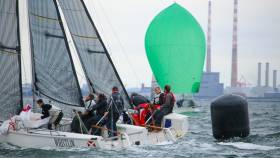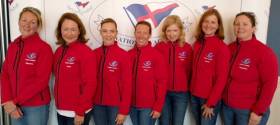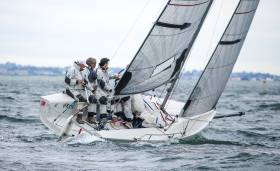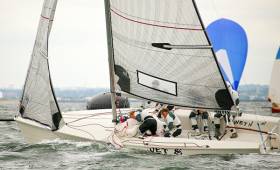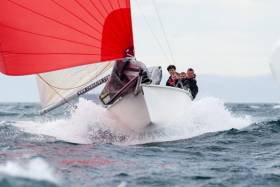Displaying items by tag: 1720
Sailing with Dutch sail numbers Anthony O'Leary has won all six races of the Sportsboats April League at Royal Cork Yacht Club writes Bob Bateman.
Sailing a 1720, the former Afloat Sailor of the Year leads Cork Harbour club–mates Clive O' Shea and Tom Durcan in another of the Royal Cork's own 1720 designs.
Third in the seven–boat fleet is a J80, Rioja, sailed by Ernie Dillon and Dominic Baxter. Full results downloadable below.
1720 'Optique' Wins DBSC Spring Chicken Series
1720 Sportsboat Optique was the overall winner of this year's DBSC Spring Chicken Series that concluded today in light winds at the National Yacht Club in Dun Laoghaire.
Second was another 1720, Merlin with one time series leader Black Velvet, a Beneteau 34.7, third overall. Over 40 boats competed in the Rathfarnham Ford spomsored series.
The DBSC Summer season begins in a month's time on Tuesday, April 25th.
1720 To The Fore in Today's Royal Cork Winter League Race
Bright sunshine and a blue sea with an eight to ten knot northerly breeze greeted competitors for the third day of the O’Leary Insurance Group Winter League in Cork Harbour today writes Bob Bateman. The first mark on the Royal Cork Yacht Club course was the Corkbeg buoy. Some competitors chose to sail beyond it to head for the eastern shore. This allowed them to avoid the worst of the ebb tide for the hard beat up to number thirteen, passing the Whitegate Refinery jetty on the way.
Once rounding thirteen it was a slalom course all the way home, a run to number eleven, a gybe and reach to number ten, a further gybe and reach to Corkbeg, more gybing and a reach to the finish between Adrielle and Cage Buoy. Race Officers for the popular winter series were again Clem and Wendy Mc Elligott.
First boat to finish was Denis Murphy’s 1720 Aquatack helmed by Michael Mc Cann followed by True Pennance Martin Darrer and Colman Garvey helmed by Roy Darrer.
1720 Championship Victory for Peter O'Leary's 'Dutch Gold' in Kinsale
After missing out on Day 2 of the 1720 Irish championship entirely due to inclement weather, OOD Peter Crowley and his team were on the water at Kinsale before 09:00 this morning and managed to complete a full programme of races for the 1720 National Championships writes Peadar Murphy. The wind today was light and shifting, but four highly competitive races were still squeezed in and had everyone ashore just before the rain swept in again.
After the first four races on Friday, Anthony O’Leary on “Antix” led from the Byrne and Wilson outfit on “ZING” and Aoife English on “Atara”. However today, the next generation of O’Learys shot to the fore on “Dutch Gold” (newly arrived from Holland!) with Peter on the helm and Robert midship providing the fleet with a masterclass in 1720 sailing in light airs. Three bullets and a second place finish rightly crowning them as the 1720 National Champions for 2016 and bringing the title to Baltimore Sailing Club, capping off a memorable week for that part of the world!
Though never quite at the front of the fleet today, Padraig Byrne and Don Wilson on “ZING” had done enough on Friday to ensure that their lesser results today still merited a second place overall. The lighter airs today seemed to suit a number of boats that hadn’t been quite in the running in strong stuff on Friday; Fionn Lyden on Baltimore Sailing Club boat “Live Wire” had a strong showing today, and might have been pushed a bit by fellow Baltimore boat “Smile n’ Wave”, though their challenge ran out of steam later in the day. Also prominent today were Paul Gibbons’ “Wahoo” and Dun Laoghaire visitor Kenneth Rumball on “Team INSS”. However, despite an off day today - Anthony O”Leary’s “Antix” came home in third overall with five points to spare over “Wahoo”.
However, the undoubted winner of the Blacks of Kinsale 1720 National Championships was Peter O’Leary.
O'Leary Leads Kinsale–Based 1720 National Championships (Photo Gallery HERE)
After four races of the 1720 National Championships at Kinsale YC in County Cork this afternoon, Antix, skippered by Anthony O'Leary of Royal Cork, leads the 16–boat fleet by two points writes Bob Bateman.
Races were sailed in a 15-knot south westerly with Antix, the current 1720 European champion, counting two wins and two seconds. O'Leary's RCYC club mates Padraig Byrne & Don Wilson are second on eight points. In third place is Howth Yacht Club and Royal Cork entry Altara skippered by Aoife English on 21 points.
Fomer Euro champion boat MICAM skippered by Mel Collins from Baltimore SC was sixth in race one but sustained gear failure and did not compete in the next three.
Friday dawned dull and with light breezes for the 16-boat fleet of the Blacks of Kinsale 1720 National Championships. OOD Peter Crowley on “Sparetime” head south to roughly one mile south of Centrepoint and laid a course to the southwest over to Black Head. The first of three scheduled races got underway with the sun starting to break through the cloud and the promise of a great day’s sailing.
Race 1 quickly established the running order for the day, with Anthony O’Leary on “Antix” and the Padraig Byrne & Don Wilson team on “ZING” coming in first and second. By the time the second race started, the sun was well established and the wind had built up. Aoife English on “Atara” scored the sole bullet of the day not taken by “Antix” or “ZING’, but had both hot on her heels. Baltimore boats "Live Wire” and “MICAM” suffered issues during the race and neither finished the race, with “MICAM”’s broken lower spreader proving terminal to her racing for the day.
For Race 3, “Live Wire” were back in business, but Denis Murphy’s “Aquatack” were not in a position to start, denting what was otherwise shaping up to be a good day’s scoring for the RCYC boat. Another perennial front-of-fleet boat - Clive O’Shea’s and Tom Durcan’s “T-Bone” was another victim of conditions in Race 3 with “ZING” scoring her sole bullet of the day. With the sun bright in the sky, strong and steady winds and a forbidding forecast for Saturday, OOD Peter Crowley elected to run a fourth race.
Fans of full-blasting were served up a treat with boats screaming down the run on the plane, with plenty of hairy gybes and more than a few broaches and wipeouts. “T-Bone” didn’t make it to the finish for their second race in a row, and “Wahoo” from RCYC also having an off race for them with a DNF dropping them from a potential third place overall at the halfway point of the championship. “Antix” and “Zing” continued to lead the way, with O’Leary claiming the final bullet of the day. Crews returned to the marina in Kinsale with broad grins, sore limbs and more than a few ripped sails and damaged lines. The marina looked reminiscent of a team garage at a Formula 1 race as efforts were made to ready the boats for what lies ahead...
Provisional results below.
1720s Will Fight For National Honours At Kinsale Yacht Club
20 boats are committed for the 1720 National Championships in Kinsale Yacht Club in a fortnight. Class Captain, Clive O'Shea, also expects some other entries that are still in the wings for the three day event that begins on Friday, September 2nd.
It's a busy period for the South Coast Club who will also host the Dragon National Championships ffrom 15th to 18th September.
National Yacht Club Ladies Contested 1720 Europeans
The National Yacht Club's new initiative to encourage more ladies sailing showed the level of its success with its all female crew entry in the 1720 Europeans held recently on Dublin Bay. The team consisted of a group of mums who either wanted to get back into sailing again after a few years break or those who were completely new to racing but wanted to give it a try. They chartered the club 1720 and trained hard coming up to the event competing in the DBSC newly created Sportsboat class on Tuesday evenings. The event, won by Royal Cork's Anthony O'Leary attracted sailing Olympians and the standard of competition is always extremely high in these fast exciting boats, so it was a steep learning curve for the NYC team. They have had lots of fun along the way with new friendships made and a big sense of achievement when those starts and gybes go just right!
The next plan is to travel further afield and enter the 1720 Nationals in Kinsale later this season. As word has spread the club now also has a ladies boat competing in the clubs RS Venture and aims to expand this further as demand among their members grows. By supporting this Women on the Water project the NYC now has a thriving group of new female sailors.
O'Leary Extends 1720 Euros Lead at Royal St.George
Royal Cork YC's Anthony O'Leary continues his lead of the 17–boat 1720 European Championships on Dublin Bay. O'Leary now has a margin of three points after scoring three seconds in races four, five and six today. Defending champion Neil Hogan stays second on 12 points. Third overall is Baltimore Sailing Club's Ben Cooke on Smile 'n' Wave. Download results below. Racing continues tomorrow as part of the National Yacht Club's Bloomsday regatta line–up.
Royal Cork Yacht Club's Anthony O'Leary leads but is on equal points with Baltimore Sailing Club's Neil Hogan after the first three races of the 1720 European Championships on Dublin Bay today. Hogan, the defending champion, scored a 3,5 and 1 today in gusty northerlies to give him nine points overall the same as O'Leary who scored 6, 1 and 2 in the 17–boat fleet. Third overall is another Baltimore SC boat, Elder Lemon skippered by Robert Dix on 12 points. Download full results below. Racing continues tomorrow.
1720 Europeans Heading for Dun Laoghaire on June 16
The 1720 European Championships will be staged in Dun Laoghaire from the 16th – 18th June and will be run between the Royal St. George, National and Royal Irish Yacht Clubs.
In a packed sailing month of June, the popular sportsboat championships follows the ICRA Nationals in Howth and ends on the same day the Round Ireland Race starts in Wicklow.
The event PRO will be Con Murphy before he heads off to Rio on Olympic duty. The final day of racing is being run as part of the National Yacht Club’s Regatta with the 1720 Class having its own start. Après Sail & overall prizegiving will be at the National Yacht Club. The event is sponsored by North Sails, McWilliam Sailmakers and Viking Marine.
It looks like Dun Laoghaire waterfront is going all out to facilitate visiting boats with Ronan Adams, sailing manager of the Royal St. George YC, promising to accommodate early arrivals and delayed departures as required. There will also be a complimentary crane lift in/out facilities at the Royal St. George and the same at the Royal Irish Yacht Club.
Ashore Adams says an Après Sail & Prize giving is planned each evening. On Thursday, an Après Sail & Prizegiving will be hosted by the Royal Irish Yacht Club with a complimentary Pimms reception. There will also be a full BBQ with a Pig on a spit available. Friday Après Sail & BBQ will be at the Royal St. George Yacht Club where the 'George’ BBQ will be available for hungry racers after sailing


























